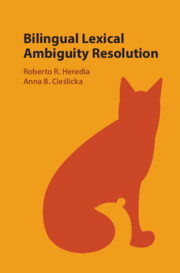Book contents
- Bilingual Lexical Ambiguity Resolution
- Bilingual Lexical Ambiguity Resolution
- Copyright page
- Dedication
- Contents
- Figures
- Tables
- Contributors
- Preface
- Acknowledgments
- Part I Theoretical and Methodological Considerations
- 1 The Cross-Modal Lexical Priming Paradigm and Bilingual Exhaustive Access
- 2 Theory Visualizations for Bilingual Models of Lexical Ambiguity Resolution
- 3 Bilingual Lexical Access
- Part II Bilingual Lexical Processing
- Part III Bilingual Sentence Processing
- Part IV Neuroscience of Bilingual Lexical Access
- Author Index
- Subject Index
- References
3 - Bilingual Lexical Access
from Part I - Theoretical and Methodological Considerations
Published online by Cambridge University Press: 24 December 2019
- Bilingual Lexical Ambiguity Resolution
- Bilingual Lexical Ambiguity Resolution
- Copyright page
- Dedication
- Contents
- Figures
- Tables
- Contributors
- Preface
- Acknowledgments
- Part I Theoretical and Methodological Considerations
- 1 The Cross-Modal Lexical Priming Paradigm and Bilingual Exhaustive Access
- 2 Theory Visualizations for Bilingual Models of Lexical Ambiguity Resolution
- 3 Bilingual Lexical Access
- Part II Bilingual Lexical Processing
- Part III Bilingual Sentence Processing
- Part IV Neuroscience of Bilingual Lexical Access
- Author Index
- Subject Index
- References
Summary
Bilingual ambiguity can arise when a word form is shared across languages but the meanings are different in each language (e.g., the word pie means foot in Spanish). The way bilinguals process this ambiguity informs us about general bilingual language processing. Do bilinguals activate both meanings of an ambiguous word or is only the meaning in the contextually relevant language activated? The current review presents studies that have explored cross-language ambiguity and the factors influencing bilingual ambiguity resolution. It examines how interactions of language context, frequency, task demands, and/or individual differences such as proficiency and executive control influence cross-language ambiguity effects. The review concludes that the bilingual language system is organized in an integrated lexicon that is accessed language-nonselectively but that it is important to take into account all of the possibly interacting factors.
Keywords
- Type
- Chapter
- Information
- Bilingual Lexical Ambiguity Resolution , pp. 42 - 68Publisher: Cambridge University PressPrint publication year: 2020
References
Further Reading
References
- 6
- Cited by



